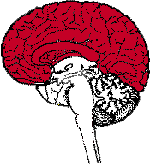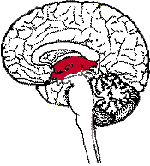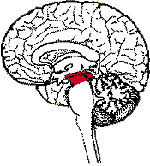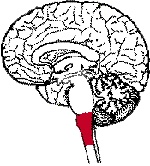
viernes, 12 de junio de 2009
GRIP A

domingo, 31 de mayo de 2009

A respiratory system's function is to allow gas exchange. The space between the alveoli and the capillaries, the anatomy or structure of the exchange system, and the precise physiological uses of the exchanged gases vary depending on the organism. In humans and other mammals, for example, the anatomical features of the respiratory system include airways, lungs, and the respiratory muscles. Molecules of oxygen and carbon dioxide are passively exchanged, by diffusion, between the gaseous external environment and the blood. This exchange process occurs in the alveolar region of the lungs. [1]
Other animals, such as insects, have respiratory systems with very simple anatomical features, and in amphibians even the skin plays a vital role in gas exchange. Plants also have respiratory systems but the directionality of gas exchange can be opposite to that in animals. The respiratory system in plants also includes anatomical features such as holes on the undersides of leaves known as stomata.
 Eyes are organs that detect light, and send signals along the optic nerve to the visual and other areas of the brain. Complex optical systems with resolving power have come in ten fundamentally different forms, and 96% of animal species possess a complex optical system.[1] Image-resolving eyes are present in cnidaria, molluscs, chordates, annelids and arthropods.[2]
Eyes are organs that detect light, and send signals along the optic nerve to the visual and other areas of the brain. Complex optical systems with resolving power have come in ten fundamentally different forms, and 96% of animal species possess a complex optical system.[1] Image-resolving eyes are present in cnidaria, molluscs, chordates, annelids and arthropods.[2] The simplest "eyes", such as those in unicellular organisms, do nothing but detect whether the surroundings are light or dark, which is sufficient for the entrainment of circadian rhythms. From more complex eyes, retinal photosensitive ganglion cells send signals along the retinohypothalamic tract to the suprachiasmatic nuclei to effect circadian adjustment.
Types of eye
Nature has produced ten different eye layouts — indeed every way of capturing an image has evolved at least once in nature, with the exception of zoom and Fresnel lenses. Eye types can be categorized into "simple eyes", with one concave chamber, and "compound eyes", which comprise a number of individual lenses laid out on a convex surface.[1] Note that "simple" does not imply a reduced level of complexity or acuity. Indeed, any eye type can be adapted for almost any behaviour or environment. The only limitations specific to eye types are that of resolution — the physics of compound eyes prevents them from achieving a resolution better than 1°. Also, superposition eyes can achieve greater sensitivity than apposition eyes, so are better suited to dark-dwelling creatures.[1] Eyes also fall into two groups on the basis of their photoreceptor's cellular construction, with the photoreceptor cells either being cilliated (as in the vertebrates) or rhabdomic. These two groups are not monophyletic; the cnidaira also possess cilliated cells, [8] and some annelids possess both.[9]
EAR
The ear is the organ that detects sound. The vertebrate ear shows a common biology from fish to humans, with variations in structure according to order and species. It not only acts as a receiver for sound, but plays a major role in the sense of balance and body position. The ear is part of the auditory system.
The word "ear" may be used correctly to describe the entire organ or just the visible portion. In most animals, the visible
ear is a flap of tissue that is also called the pinna. The pinna may be all that shows of the ear, but it serves only the first of many steps in hearing and plays no role in the sense of balance. In people, the pinna is often called the auricle. Vertebrates have a pair of ears, placed symmetrically on opposite sides of the head. This arrangement aids in the ability to localize sound sources.
Introduction to ears and hearing
Audition is the scientific name for the perception of sound. Sound is a form of energy that moves through air, water, and other matter, in waves of pressure. Sound is the means of auditory communication, including frog calls, bird songs and spoken language. Although the ear is the vertebrate sense organ that recognizes sound, it is the brain and central nervous system that "hears". Sound waves are perceived by the brain through the firing of nerve cells in the auditory portion of the central nervous system. The ear changes sound pressure waves from the outside world into a signal of nerve impulses sent to the brain.
The outer part of the ear collects sound. That sound pressure is amplified through the middle portion of the ear and, in land animals, passed from the medium of air into a liquid medium. The change from air to liquid occurs because air surrounds the head and is contained in the ear canal and middle ear, but not in the inner ear. The inner ear is hollow, embedded in the temporal bone, the densest bone of the body. The hollow channels of the inner ear are filled with liquid, and contain a sensory epithelium that is studded with hair cells. The microscopic "hairs" of these cells are structural protein filaments that project out into the fluid. The hair cells are mechanoreceptors that release a chemical neurotransmitter when stimulated. Sound waves moving through fluid push the filaments; if the filaments bend over enough it causes the hair cells to fire. In this way sound waves are transformed into nerve impulses. In vision, the rods and cones of the retina play a similar role with light as the hair cells do with sound. The nerve impulses travel from the left and right ears through the eighth cranial nerve to both sides of the brain stem and up to the portion of the cerebral cortex dedicated to sound. This auditory part of the cerebral cortex is in the temporal lobe.
The part of the ear that is dedicated to sensing balance and position also sends impulses through the eighth cranial nerve, the VIIIth nerve's Vestibular Portion. Those impulses are sent to the vestibular portion of the central nervous system. The human ear can generally hear sounds with frequencies between 20 Hz and 20 kHz (the audio range). Although the sensation of hearing requires an intact and functioning auditory portion of the central nervous system as well as a working ear, human deafness (extreme insensitivity to sound) most commonly occurs because of abnormalities of the inner ear, rather than the nerves or tracts of the central auditory system.[1]
The digestive tract (also known as the alimentary canal) is the system of organs within multicellular animals that takes in food, digests it to extract energy and nutrients, and expels the remaining waste. The major function of the GI tract are ingestion, digestion, absorption, and defecation. The GI tract differs substantially from animal to animal. Some animals have multi-chambered stomachs, while some animals' stomachs contain a single chamber. In a normal human adult male, the GI tract is approximately 6.5 meters (20 feet) long and consists of the upper and lower GI tracts. The tract may also be divided into foregut, midgut, and hindgut, reflecting the embryological origin of each segment of the tract.[1]
The remainder of this article focuses on human anatomy; see digestion for the process in other organisms.
The circulatory system is an organ system that transports nutrients, blood gases, hormones, blood cells, waste products, etc. to and from cells in the body to help fight diseases and help stabilize body temperature and pH to maintain homeostasis. This system may be seen strictly as a blood distribution network, but some consider the circulatory system as composed of the cardiovascular system, which distributes blood, and the lymphatic system, which distributes lymph. While humans, as well as other vertebrates, have a closed cardiovascular system (meaning that the blood never leaves the network of arteries, veins and capillaries), some invertebrate groups have an open cardiovascular system. The most primitive animal phyla lack circulatory system. The lymphatic system, on the other hand, is an open system.
The main components of the human circulatory system are the heart, the blood, and the blood vessels. The circulatory system includes: the pulmonary circulation, a "loop" through the lungs where blood is oxygenated; and the systemic circulation, a "loop" through the rest of the body to provide oxygenated blood. An average adult contains five to six quarts (roughly 4.7 to 5.7 liters) of blood, which consists of plasma, red blood cells, white blood cells, and platelets. Also, the digestive system works with the circulatory system to provide the nutrients the system needs to keep the heart pumping.
Two types of fluids move through the circulatory system: blood and lymph. The blood, heart, and blood vessels form the cardiovascular system. The lymph, lymph nodes, and lymph vessels form the lymphatic system. The cardiovascular system and the lymphatic system collectively make up the circulatory system.
Three types of circulation:
Pulmonary circulation is the portion of the cardiovascular system which transports oxygen-depleted blood away from the heart, to the lungs, and returns oxygenated blood back to the hearth,
Systemic circulation is the portion of the cardiovascular system which transports oxygenated blood away from the heart, to the rest of the body, and returns oxygen-depleted blood back to the heart. Systemic circulation is, distance-wise, much longer than pulmonary circulation, transporting blood to every part of the body except the lungs.
coronary circulatory system provides a blood supply to the heart. As it provides oxygenated blood to the heart, it is by definition a part of the systemic circulatory system.
viernes, 22 de mayo de 2009
DIVISION OF THE NERVOUS SYSTEM

The nervous system can be divided into several connected systems that function together. Let's start with a simple division:
The nervous system is divided into the central nervous system and peripheral nervous system.
Peripheral Nervous System
The peripheral nervous system is divided into two major parts: the somatic nervous system and the autonomic nervous system.
Somatic Nervous System
The somatic nervous system consists of peripheral nerve fibers that send sensory information to the central nervous system AND motor nerve fibers that project to skeletal muscle.
The picture on the left shows the somatic motor system. The cell body is located in either the brain or spinal cord and projects directly to a skeletal muscle.
Autonomic Nervous System
 Th
Th
e autonomic nervous system is divided into three parts: the sympathetic nervous system, the parasympathetic nervous system and the enteric nervous system. The autonomic nervous system controls smooth muscle of the viscera (internal organs) and glands.
This picture shows the general organization of the autonomic nervous system. The preganglionic neuron is located in either the brain or the spinal cord. This preganglionic neuron projects to an autonomic ganglion. The postganglionic neuron th
en projects to the target organ. Notice that the somatic nervous system has only one neuron between the central nervous system and the targe
t organ while the autonomic nervous system uses two neurons.
| Divisions of the Nervous System | ||
 Telencephalon Telencephalon |  Diencephalon Diencephalon |  Mesencephalon Mesencephalon |
 Metencephalon Metencephalon |  Myelencephalon Myelencephalon |
From a top view, notice how the brain is divided into two halves, called hemispheres. Each hemisphere communicates with the other through the corpus callosum, a bundle of nerve fibers. (Another smaller fiber bundle that connects the two hemispheres is called the anterior commissure).
Some differences between the peripheral nervous system (PNS) and the central nervous system (CNS):
- In the CNS, collections of neurons are called nuclei. In the PNS, collections of neurons are called ganglia.
- In the CNS, collections of axons are called tracts. In the PNS, collections of axons are called nerves.
In the peripheral nervous system, neurons can be functionally divided in three ways:
- Sensory (afferent) - carry information INTO the central nervous system from sense organs or motor (efferent) - carry information away from the central nervous system (for muscle control).
- Cranial - connects the brain with the periphery or spinal - connects the spinal cord with the periphery.
- Somatic - connects the skin or muscle with the central nervous system or visceral - connects the internal organs with the central nervous system.
Cerebral Cortex
Functions:
- Thought
- Voluntary movement
- Language
- Reasoning
- Perception
Cerebellum
Functions:
- Movement
- Balance
- Posture
Brain stem
Functions: 
- Breathing
- Heart Rate
- Blood Pressure
Hypothalamus
Functions: 
- Body Temperature
- Emotions
- Hunger
- Thirst
- Circadian Rhythms
Thalamus
Functions: 
- Sensory processing
- Movement
Limbic System
Functions:
- Emotions
- Memory
Hippocampus
Functions:- Learning
- Memory
Basal Ganglia
Functions:
- Movement
The basal ganglia are a group of structures, including the globus pallidus, caudate nucleus, subthalamic nucleus, putamen and substantia nigra, that are important in coordinating movement.
Midbrain
Functions:
- Vision
- Audition
- Eye Movement
- Body Movement
The midbrain includes structures such as the superior and inferior colliculi and red nucleus. There are several other areas also in the midbrain.
lunes, 30 de marzo de 2009
Exam unit 1: levels of organisation
es la forma de vida mes petita que hi ha.Es un cos amb volum que transforma energía i es capaç de transferir informació.Tots estam formats pero cel·lules
2. Escriu el nom dels orgànuls i de les parts de les cèl·lules eucariotes que es corresponen amb les funcions proposades
Digestió Lysosomes
Locomoció Cilia and flagella
Magatzem de nutrients Vacuoles
Fotosíntesi Chloropalsts
Síntesi de proteïnes Ribosomes
Suport de la cèl·lula Endoplasmatic reticulum
3. Fes una llista dels aparells i sistemes que formen el cos humà. Quines són els tres funcions vitals dels éssers vius? Quins aparells i sistemes participen en cadascuna d'elles. ( contesta al full apart.) Digestive,respiratory,circulatory,excretory.
4. Relaciona els termes següents (escriu a la dreta de la segona columna què són):
Bacterium (cell)
Cell Heart (tissue)
Tissue Onion Epidermis (tissue)
Organ Red blood cell (cell)
Apparatus (organ system) A cat (organism)
Organism Nervous system (apparatus)
A potato plant (organism)
5. Indica si són veritables (V) o falses (F) les afirmacions següents.
The bigger animals have bigger cells than the smaller animals.(F)
There are no organisms made up of only one cell. (V)
Bacteria have no nucleus (V)
The shape of cells is very varied. (V)
Vegetables are made up of procaryotic cells. (F)
All eucaryotic cells have cell organelles. (V)
Procaryotic cells have got a cytoplasm. (F)
We usually measure the length of a cell in centimetres. (F)
6. Explain the most important differences between the two main kinds of cells:
Eucaryotic cells
Size small(1µm) bigger(10-100µm)
Nucleus yes -
Organelles yes -
Write down any other additional difference between them that it is worth mentioning.
8. Com es classifiquen els teixits del cos humà? Fes-ne un esquema o explica els quatre tipus bàsics de teixits i les seves diferents classes.
9. Label the illustration:
.jpg)




